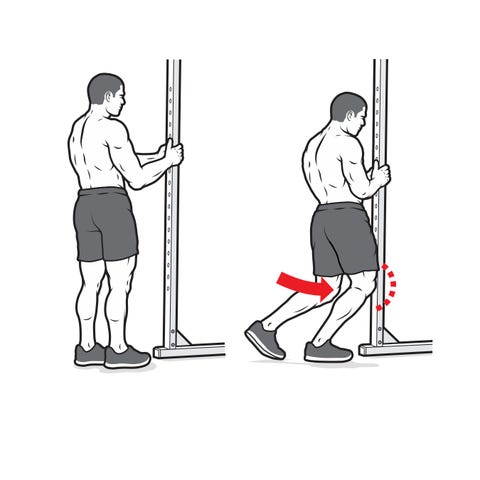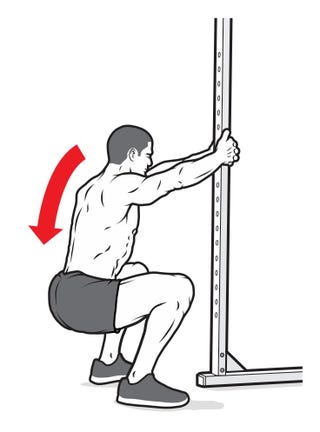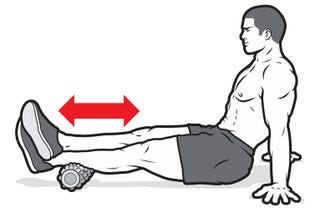Do your knees, hips, or back sometimes hurt for seemingly random reasons? Do running, lifting, and playing sports leave you sore in the wrong places? Do you walk around gingerly, feeling stiff all over? This three-second test may reveal the reason.
Stand up and kick off your shoes. Spread your feet hip-width apart with your toes pointing straight ahead. Now squat. Go as low as you possibly can, making sure you don’t raise your heels off the floor or slump forward. If you couldn’t drop your butt to just a few inches above the ground, you just discovered your problem.
“Sitting in a squat position is the most natural movement for the body,” says Roop Sihota, a Bay Area physical therapist. That’s because the joints and muscles you need for squatting—hips, knees, ankles, core, quads, glutes, and more—are your powerhouses for everything from walking and running to swinging a golf club and doing yard work. If you can’t squat properly, your joints are probably too stiff and your muscles too tight. That causes you to lose your ability to move properly, which in turn affects delicate areas such as your knees and back.
The result? Potential pain and injury, and decreased range of motion over the long haul. That’s why learning to squat might be the most important thing you can do for your fitness and wellness. If you’re wondering why you failed the test in the first place, the answer is simple. Humans were meant to sit in the squat position. Then chairs came along.
Learning to squat might be the most important thing you can do for your fitness and wellness.
Ever since first grade you’ve probably been sitting in a chair eight hours a day, five days a week. A chair delivers comfort, sure, but it’s also an unnatural structure that your body adapts to. Such cultural practices as skull flattening and neck stretching proved this phenomenon quite effectively.
In a chair sitting position, your hip and ankle muscles shorten and your stabilizing core muscles turn off because the chair supports your body. Over time, your hips and ankles tighten while the core areas weaken, explains Doug Kechijian, a physical therapist with Resilient PT in New York City. Tight, weak muscles are a recipe for pain, injury, and compromised performance. But when we spend a greater amount of time squatting, our hips and ankles don’t become tight or weak.
When a muscle becomes overly tight, your brain may sense the area as threatened and send pain there as a way to entice you to move, says Kechijian. For example, sciatica—a chronic pain in the ass, literally—occurs when your hip muscles become too tight. The reason therapies such as foam rolling and stretching temporarily relieve pain is that they reduce some tension. Learning to squat correctly means you’ll loosen these muscles for good and banish your pain.

Performing nearly any physical activity on tight and weak muscles is a bad idea. If you run on immobile ankles and tight hips, you risk hamstring or knee injuries because power and impact shifts to the wrong areas, says Marco Sanchez, cofounder of Movement as Medicine, a massage and movement therapy clinic outside Boston.
When a guy with tight hips and ankles picks up anything from a barbell to a bag of mulch, he can’t reach the ground while keeping his back straight. So his spine bends, sending the load there. That can cause a disc bulge—and a world of hurt. Nearly every sport requires motion from the hips because your hips give your body rotational power. Take golf: If your hips are too tight, driving a ball can lead to back pain because you’re moving from your spine instead of your hips.
“An inability to squat can lead to pain or injury in every joint in the body,” Sihota says. In fact, research shows that people in rural areas of some developing countries where the “sit squat” is a common resting position have the lowest incidence of posture-related problems, like lower-back pain.
In your workouts, a full range of motion in moves like the barbell squat and the deadlift is impossible if lack of flexibility in your hips and ankles make it difficult for you to drop into a full or deep squat. (And if you do it anyway, you could be vulnerable to pain or injury, especially if you’ve loaded up the weight.) That makes the exercise less effective because you engage fewer muscles and keep them under tension for less time. The result: You see less return from your work-out for the same amount of effort.
Learning to squat properly is more than a game changer—it’s a life changer. You’ll notice fewer aches and pains. You’ll reduce your risk of injury. You’ll build more muscle across your body. Best of all, you’re likely to see your performance improve—running faster, smashing a ball farther, punching harder—in just about every activity you do.
How to Squat
These tests can help identify what’s sabotaging your squat. You may have just one problem area, or three—hips, core, and ankles. Feel free to do the fix for longer than we recommend; it’ll only help you reach your goal faster.
Test Yourself
Hips and/or Core

This test tells you whether your problem is tight hips or a weak core. Lie on your back and assume a squat position lying down: Bring your knees as close to your chest as you can. Can’t get them past your hips? Your hips are too tight. If you can bring your knees high, then your core just isn’t strong or stable enough to support your squat position while standing, says Sanchez.
Ankles

Your ankles need to flex enough to let your knees track over your feet, allowing you to distribute your weight evenly. This test tells you whether your ankles are too stiff to allow that. Stand in a staggered stance facing a wall, your front foot 5 inches from it. Push your front knee as far forward as you can, attempting to touch the wall with it. If your knee can’t touch the wall, you failed.
Fix Yourself
Core

Hold onto a doorjamb, the frame of a squat rack, or a chair. Now drop into a squat, using the frame, rack, or chair to stabilize your body just enough to keep from falling. Your torso should be upright and you should feel your core engage. Breathe deeply in the position for up to 30 seconds. Stand up. That’s 1 rep. Do 3 reps, 3 days a week.
Hips

Get down on all fours. Extend your left leg; your knee should be above the floor. Move your right foot beneath your left leg and “pin” your right heel to the outside of your left knee. This is the starting position. Now move your hips back and forth to the right for 1 minute, feeling your right hip stretch. Switch sides and repeat. Do this drill once a day.
Ankles

Do the ankle test above for 3 sets of 5 reps every day. Also foam roll each calf for 1 minute a day: Grab a foam roller, sit on the floor, and place the roller under your right calf. Roll up and down the muscle for 60 seconds. Repeat on your other calf. For a more targeted massage, you can try this technique with a tennis or lacrosse ball.
Take the Ultimate Squat Test
If you can squat well already, get down in the position and try to hold it with good form for 10 minutes (and have a copy of The Iliad handy so you don’t get bored). If you can’t do 10 minutes straight, build up to it by holding the squat for as long as you can. Rest for the same amount of time and repeat until you hit 10 minutes. This extended time “locks in” the position, helping to establish the move.
Source: Read Full Article
